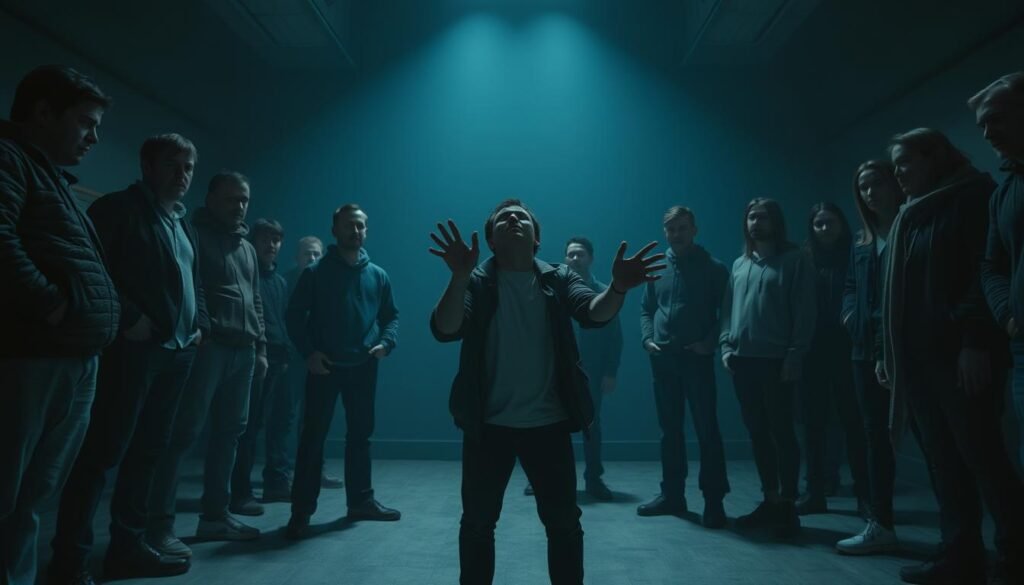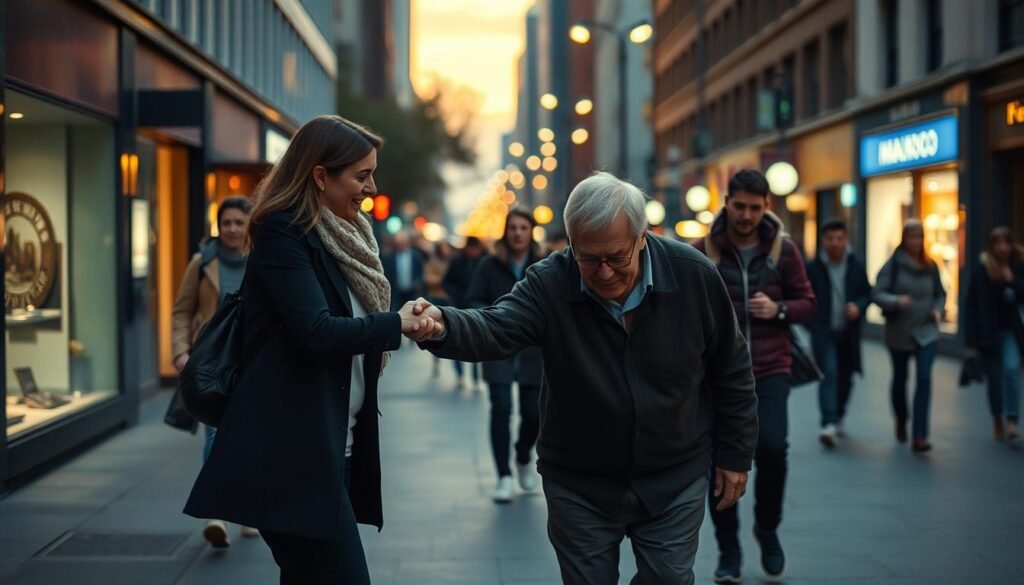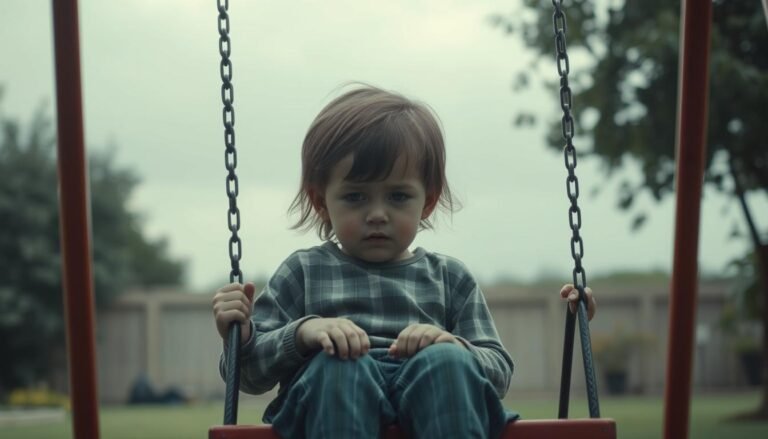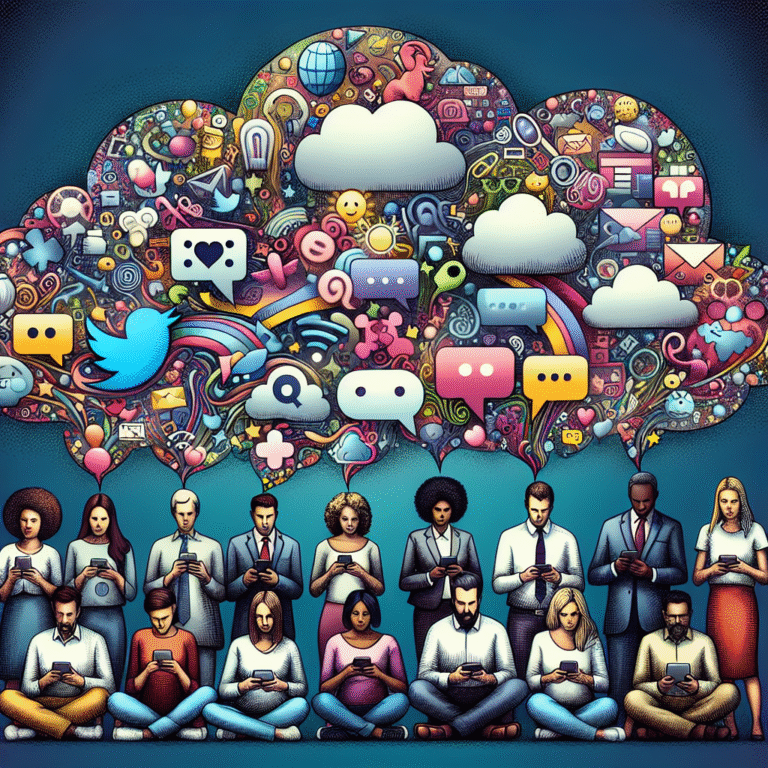
Have you ever seen someone in trouble, but no one helped? This is called the bystander effect, a key topic in emergency psychology. Studies show that when many people are around, fewer help out.
So, why doesn’t anyone help? Is it because they don’t care or because they think someone else will? Figuring out why is key to making people more likely to help in emergencies.
Key Takeaways
- The presence of others can discourage an individual from intervening in an emergency.
- The bystander effect is a widely studied phenomenon in psychology.
- Understanding the causes of the bystander effect can help develop strategies to overcome it.
- Diffusion of responsibility is a possible reason for the bystander effect.
- Empathy and awareness are important for encouraging people to help.
Understanding the Bystander Effect
The bystander effect shows that people are less likely to help when in a group than alone. This idea is important in social psychology. It shows how complex it can be to decide whether to help or not.
Definition of the Bystander Effect
The bystander effect means people are less likely to help when others are around. Diffusion of responsibility plays a big role. People think others will act, so they don’t feel responsible to help.
When more people are around, it’s less likely someone will help. This happens in many situations, from small problems to big emergencies.
Historical Background
Psychologists and sociologists have studied the bystander effect for years. The murder of Kitty Genovese in 1964 was a key moment. It shocked people because many witnesses didn’t help or report the crime.
This event led researchers like Bibb Latané and John Darley to study it. They found out how others affect our willingness to help.
Key Studies and Findings
Studies have found important things about the bystander effect. Being with others can make us less likely to act because we think others will. Fear of what others think and group dynamics also affect our actions.
| Study | Key Finding |
|---|---|
| Latané and Darley (1968) | They showed in a lab that people are less likely to report smoke when with others who don’t react. |
| Darley and Latané (1968) | They found people are more likely to help if they think they’re the only one watching an emergency. |
It’s important to understand the bystander effect to help more people. By studying why we don’t help, we can make it easier to do so.
The Psychology Behind the Bystander Effect
The bystander effect is complex, involving social influence, diffusion of responsibility, and fear of judgment. When people are in a group, they often follow what others do. This leads to social loafing.
Social Influence and Group Dynamics
Social influence is key in the bystander effect. With many bystanders, each person thinks someone else will act. This leads to group inaction.
The size of the group also matters. In a big group, everyone feels less responsible to act. This makes it less likely for anyone to help.
Diffusion of Responsibility
Diffusion of responsibility is a big part of the bystander effect. When there are many people, each one thinks someone else will help. This is linked to altruism psychology, which studies why people help others.
Fear of Judgment
Fear of judgment also plays a role. People might not help because they worry about what others will think. This fear makes them hesitant to act, preferring to avoid disapproval.
Knowing these factors helps us find ways to encourage helping behavior. It’s important to understand these psychological aspects to overcome the bystander effect.
Factors Influencing the Bystander Effect
Many things can affect if someone helps in an emergency. These include the situation, the person’s traits, and cultural norms. Each plays a big role in how people act when they see someone in trouble.
Situational Context
The setting of an emergency greatly affects bystander actions. For example, being around others can make people think someone else will help. Unclear emergencies can also stop people from acting, as they might not see the danger.
Where the emergency happens also matters. Emergencies in public places with lots of people might make people less likely to help. This is because they think others will act instead.

Individual Characteristics
Who a person is can also affect their actions in emergencies. Those with prosocial traits like empathy are more likely to help. Also, people who know first aid are more confident to act.
Cultural Influences
Cultural values can also shape how people react in emergencies. In cultures that value collectivism and community support, helping others is more common. But in cultures that focus on individualism, people might be less likely to help.
By looking at these factors, we can learn more about the bystander effect. This knowledge helps us find ways to encourage helping in emergencies.
Notable Case Studies
Case studies offer deep insights into the bystander effect. They show why people often don’t help in emergencies. These examples help us grasp the psychological and social reasons behind this.
The Murder of Kitty Genovese and Latane’s Research
The Kitty Genovese case is a famous example of the bystander effect. In 1964, Kitty Genovese was attacked in New York City. Despite her cries for help, 38 neighbors did nothing. This event led to a lot of anger and research by Bibb Latane and John Darley.
Their work created the bystander effect theory. It says that many bystanders can make it less likely for anyone to help. Latane and Darley found that being with others can make people think someone else will act.
Bystander Behavior in Natural Disasters
The bystander effect isn’t just for city crimes. It also happens in natural disasters. In hurricanes, earthquakes, and tsunamis, people often don’t help, even when it’s urgent. The chaos and danger of these situations make it worse.
The 2010 Haiti earthquake is a clear example. Survivors said many bystanders didn’t help. Studying these cases helps us find ways to stop the bystander effect in disasters.
| Case Study | Context | Key Factors |
|---|---|---|
| Kitty Genovese Murder | Urban Crime | Diffusion of responsibility, social influence |
| 2010 Haiti Earthquake | Natural Disaster | Chaos, confusion, perceived danger |
As Bibb Latane said, “The bystander effect is complex. It’s influenced by many things, like who is watching, the emergency, and where it happens.” Knowing these factors helps us find ways to fight the bystander effect.
How bystander behavior varies
Looking into bystander behavior shows us how settings and demographics matter. It’s not the same everywhere. The place where an emergency happens can change how people react.
Differences in Urban vs. Rural Settings
The setting affects whether someone will help. People in rural areas tend to help more than city dwellers. This is because rural areas often have a stronger community feeling.
But cities are different. They have more people who don’t know each other. This can lead to social loafing. People might think someone else will help, so they don’t.
The Role of Personal Relationships
Knowing someone in need can make a big difference. When bystanders know the person, they’re more likely to help. This is because personal ties can make people more willing to act for others.
| Relationship Type | Likelihood of Helping |
|---|---|
| Stranger | Low |
| Friend | High |
| Family Member | Very High |
Influences of Age and Gender
Age and gender also shape bystander behavior. Older people tend to help more, possibly because of their life experience. They feel more responsible for society.
When it comes to gender, research is not clear-cut. But some studies say men might help in some emergencies, while women might in others. This could reflect old gender roles.
Bystander Intervention: When People Choose to Help
While the bystander effect is a big concern, there are many examples of people helping. It’s important to understand what makes someone help in an emergency. This helps us promote good behavior.
Factors Encouraging Action
Several things help people step in, like how serious they think the situation is. Empathy is key because it lets bystanders feel the victim’s pain. This motivates them to act.
“The decision to intervene is often influenced by a complex interplay of psychological and social factors,” notes a study on prosocial behavior psychology. Recognizing the need for help and feeling able to assist are also key. These factors decide if someone will help.

The Role of Empathy
Empathy is vital in bystander intervention. It lets people understand and share the victim’s feelings. Studies show that those with more empathy are more likely to help.
Teaching empathy through education and awareness can boost bystander intervention. This makes it a good strategy to promote helping.
Training and Awareness Programs
Training programs teach people to spot emergencies and know how to respond. They cover first aid, CPR, and crisis management. This training gives bystanders the skills to help effectively.
Awareness campaigns also play a big role. They show the importance of helping in emergencies. These campaigns help build a community that looks out for each other.
Real-Life Examples of Bystander Intervention
Looking at real-life examples of bystander intervention shows us what drives altruism psychology and helping behavior in emergencies. These stories are complex and teach us about promoting positive actions in critical moments.
Success Stories
Many times, bystanders have stepped up in emergencies, saving lives and preventing more harm. For example, during the 2009 Victorian bushfires in Australia, people risked their lives to help others escape. These acts of bravery show our capacity for altruism and why it’s key to understand what drives it.
- A bystander in New York City stopped a subway train after seeing a man fall onto the tracks.
- In another case, a group of bystanders worked together to save a child who had wandered onto a busy highway.
These stories show the power of positive intervention. They prove that, with the right circumstances, people can overcome the bystander effect and act decisively.
Lessons Learned from Bystander Heroes
Studying the actions of bystander heroes reveals important factors that make them willing to help. Research in emergency psychology shows that people are more likely to help when:
- They feel personally responsible.
- They think their help is needed.
- They have the skills or knowledge to assist.
“The key to bystander intervention lies not just in the individual’s character, but in the situational factors that either encourage or discourage action.” –
By grasping these factors, we can work on strategies to boost bystander intervention. This helps create a culture that supports helping in emergencies.
Addressing the Bystander Effect in Society
To fight the bystander effect, we need a plan that includes awareness, education, and media. Understanding why people don’t help can help us find ways to make them act. This way, we can encourage more people to help and reduce inaction.
Community Awareness Initiatives
Community programs are key in fighting the bystander effect. They teach people the importance of helping in emergencies. Programs that promote empathy and understanding of social responsibility can make people more willing to help. For example, sharing stories of people who helped can motivate others to do the same.
As Darley and Latané found, not helping is not because people are apathetic. It’s because they think someone else will act.
“The presence of others makes it more difficult for an individual to take action because the responsibility is diffused among the group members.”
These programs can help by making people feel personally responsible.
Educational Programs in Schools
Schools play a big role in teaching kids to be kind and responsible. By adding bystander intervention training to school, we can raise a generation of helpers. These programs teach kids how to act in emergencies and build a caring community.
Studies show that teaching kids about empathy and kindness works. For example, a study on social-emotional learning programs found kids were more likely to help and less likely to be aggressive.
Media Campaigns for Change
Media campaigns can change how we think and act. They use different platforms to spread messages of kindness and responsibility. Good campaigns use stories and images to inspire people to act.
For instance, campaigns that show the good of helping can motivate people to act in their communities. As the saying goes, “
‘The smallest act of kindness is worth more than the grandest intention.’
” Media can turn good intentions into real actions by giving people the push they need.
The Impact of Technology on Bystander Behavior
Technology has changed how we react to emergencies. Smartphones and social media have altered how we witness and act in critical situations.

Social Media and Instant Reporting
Social media is key in reporting emergencies and getting help fast. It spreads information quickly, which can speed up responses. This change affects emergency psychology, as quick reports can shape the response.
Social media plays a big role in bystander actions. It lets people report incidents and call for help. But it can also make people feel less responsible, knowing others are documenting it online.
Bystanders Capturing Events on Video
Smartphones have made it common for bystanders to record emergencies. This has both good and bad sides for helping behavior. Videos can be useful and raise awareness, but recording can sometimes stop people from helping directly.
Sharing these videos online can also change how people see emergencies. It can build a sense of community and encourage helping. But it can also make people feel like spectators, leading to desensitization.
In summary, technology has greatly changed bystander behavior. It offers chances and challenges for promoting altruism psychology and helping behavior in emergencies.
Overcoming the Bystander Effect
The bystander effect can be lessened by using both personal and community efforts. Learning these methods can boost helping actions and build a culture of empathy and duty.
Strategies for Individuals
People can greatly help overcome the bystander effect. They can do this by using certain strategies that encourage helping. These include:
- Awareness and Empathy: Knowing what’s around you and feeling for those in trouble can really help.
- Prosocial Behavior: Doing good deeds, like volunteering, can make others want to help too.
- Training and Education: Learning how to intervene in emergencies can give you the courage to act.
By using these strategies every day, we can help create a society that values helping and caring.
Role of Influencers and Community Leaders
Leaders and influencers are key in shaping our culture and actions. They can greatly help by:
- Promoting Awareness: Sharing info about the bystander effect and why helping is important.
- Modeling Behavior: Showing kindness and helping others sets a good example for everyone.
- Supporting Initiatives: Supporting programs that teach how to help and foster empathy.
| Strategy | Description | Impact |
|---|---|---|
| Awareness and Empathy | Being aware of surroundings and empathizing with those in need | Promotes helping behavior |
| Prosocial Behavior | Engaging in volunteering or helping others | Reinforces positive behaviors |
| Influencer Promotion | Using platforms to raise awareness about the bystander effect | Shapes cultural norms and behaviors |
Together, we can build a society that’s more willing to help. This way, we can beat the bystander effect.
The Future of Bystander Action
The future of bystander action depends on changing cultural norms and making policy changes. Understanding these areas can help create a culture that values helping. This is key for encouraging people to act in emergencies.
Changing Cultural Norms
Changing cultural norms means changing how society views bystander behavior. By promoting helping behavior, we can make it more common. This can be done through:
- Community awareness initiatives that highlight the importance of bystander intervention.
- Educational programs in schools that teach children and adolescents about the value of helping others.
- Media campaigns that showcase positive examples of bystander action, making it seem normal.
By changing how we view bystander behavior, we can fight social loafing. This is when people think others will act, instead of doing it themselves. We aim to promote altruism psychology, making people feel responsible to help others.
Potential for Policy Changes
Policies can also greatly impact bystander action. Governments and organizations can make laws and programs that support bystander intervention. For example:
- Good Samaritan laws that protect those who help in emergencies.
- Mandatory training programs for bystander intervention, in schools or workplaces.
- Public awareness campaigns to promote a culture of helping.
By combining cultural changes with policy updates, we can encourage bystander action more effectively. As Dr. Bibb Latané said, “The key to understanding bystander behavior lies in recognizing the power of social influence.” With this knowledge, we can aim for a future where bystander action is common.
Final Thoughts on the Bystander Effect
Understanding the bystander effect is key to helping in emergencies. We can learn from the psychological and social factors that affect bystanders. This knowledge helps us find ways to get more people involved.
Personal Responsibility in Emergencies
It’s important to take personal responsibility to beat the bystander effect. When we own our actions, we’re more likely to help others. This comes from empathy and wanting to assist those in need.
Fostering a Culture of Helping Behavior
To create a culture that values helping, we need a few steps. We should teach empathy and helping through education and community projects. Also, using technology to report and respond to emergencies is vital in emergency psychology.
Together, we can build a society where people feel ready to help in emergencies. This way, we can lessen the bystander effect and empower individuals to act.














